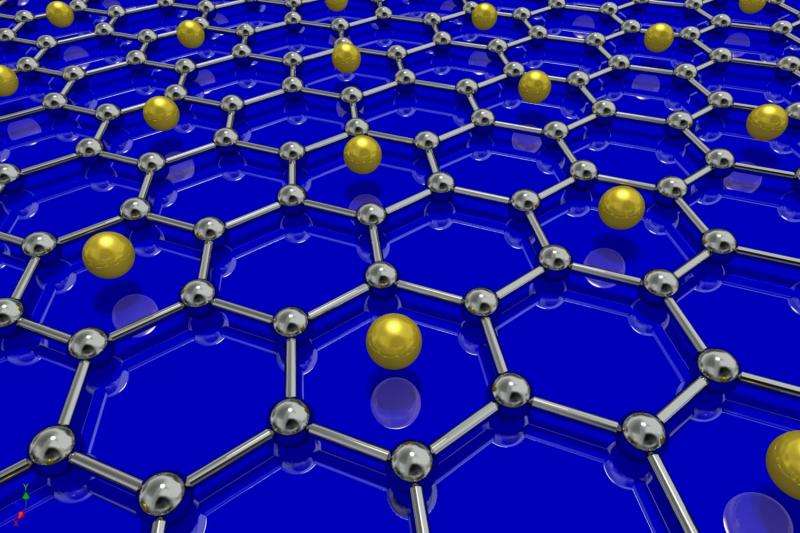September 2, 2015 report
Graphene made superconductive by doping with lithium atoms
![Charge-transfer doping of graphene by lithium adatoms. Credit: arXiv:1508.05925 [cond-mat.supr-con] Graphene made superconductive by doping with lithium atoms](https://scx1.b-cdn.net/csz/news/800a/2015/55e6f25137d89.jpg)
(Phys.org)—A team of researchers from Germany and Canada has found a way to make graphene superconductive—by doping it with lithium atoms. In their paper they have uploaded to the preprint server arXiv, the team describes the process they used and the results they obtained when testing it.
By now, most everyone in the science community is aware of graphene, the single carbon atom layer of material that is being studied to figure out how it can be mass produced and connected to other devices to take advantage of its superior electrical properties. Some have also been looking into whether the material could be made into a superconductor—prior research a decade ago showed that graphite could be made superconductive by coating it with other materials. Since that time, the search has been on to find just the right coating for graphene. Three years ago, a group in Italy created a model that suggested lithium might be the right choice, now, based on the work done by this latest team, it appears that they might have been right.
In this effort, the researches first grew samples of graphene on a silicon-carbide substrate—those samples were then placed in a vacuum and cooled to 8K and were then "decorated" very precisely with a layer of lithium atoms. To convince themselves that the result was superconductive, the team tested the material with angle-resolved photoemission spectroscopy—doing so revealed that electrons sent through the material slowed down, which they suggest was the result of electron-phonon coupling (the creation of Cooper pairs)—one of the hallmarks of a superconductor. The team also identified an energy gap between those electrons that were conducting and those that were not, energy that would be needed to brake electron-phonon coupling.
Further tests will have to be done to discover if it is possible to demonstrate a complete loss of electrical resistance and the expulsion of an external magnetic field, tests that can prove the material to be a true superconductor.

In related news, another group working at Sungkyunkwan University in South Korea has also been working with coating graphene with lithium and in their paper also uploaded to arXiv, they claim they have observed superconductivity in samples of layers of graphene doped with lithium.
More information: Evidence for superconductivity in Li-decorated monolayer graphene, arXiv:1508.05925 [cond-mat.supr-con] arxiv.org/abs/1508.05925
Abstract
Monolayer graphene exhibits many spectacular electronic properties, with superconductivity being arguably the most notable exception. It was theoretically proposed that superconductivity might be induced by enhancing the electron-phonon coupling through the decoration of graphene with an alkali adatom superlattice [Profeta et al. Nat. Phys. 8, 131-134 (2012)]. While experiments have indeed demonstrated an adatom-induced enhancement of the electron-phonon coupling, superconductivity has never been observed. Using angle-resolved photoemission spectroscopy (ARPES) we show that lithium deposited on graphene at low temperature strongly modifies the phonon density of states, leading to an enhancement of the electron-phonon coupling of up to λ≃0.58. On part of the graphene-derived π∗-band Fermi surface, we then observe the opening of a Δ≃0.9 meV temperature-dependent pairing gap. This result suggests for the first time, to our knowledge, that Li-decorated monolayer graphene is indeed superconducting with Tc≃5.9K.
Journal information: arXiv
© 2015 Phys.org





















